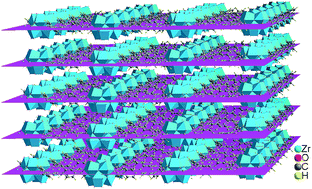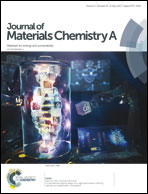Kinetically controlled synthesis of two-dimensional Zr/Hf metal–organic framework nanosheets via a modulated hydrothermal approach†
Abstract
The kinetically controlled synthesis of two-dimensional (2D) metal–organic framework (MOF) nanosheets in the absence of surfactants is rewarding but challenging. We herein describe such a surfactant-free bottom-up synthesis of 2D stable Zr/Hf MOF nanosheets named NUS-8 composed of Zr6O4(OH)4 or Hf6O4(OH)4 clusters and 1,3,5-benzenetribenzoate (BTB3−) via a modulated hydrothermal approach, which allows fast precipitation and stabilization of intermediate 2D metal–organic nanosheets due to the heterogeneous synthetic conditions. Structural analyses based on synchrotron powder X-ray diffraction data confirm the 2D layered structure of NUS-8 with uniform porosity and highly accessible Lewis acid sites suitable for heterogeneous catalysis. 2D NUS-8 nanosheets exhibit excellent stabilities superior to those of their interlocked 3D MOF analogues synthesized from solvothermal synthesis, which are evidenced by comprehensive stability tests. In particular, dynamic mechanical analysis (DMA) experiments suggest that the stability of 2D NUS-8 nanosheets may come from a combination of interlayer shear sliding deformation and out-of-plane tension/compression modes whereas their interlocked 3D architecture is strictly constrained. Because of the alleviated framework strain and accessible active sites, NUS-8 nanosheets exhibit excellent stability and catalytic activity superior to those of their interlocked 3D MOF counterparts. Our work has demonstrated the potential of a modulated hydrothermal approach in the kinetically controlled synthesis of 2D MOF nanosheets, shedding light on future synthesis of 2D hybrid inorganic–organic materials.



 Please wait while we load your content...
Please wait while we load your content...